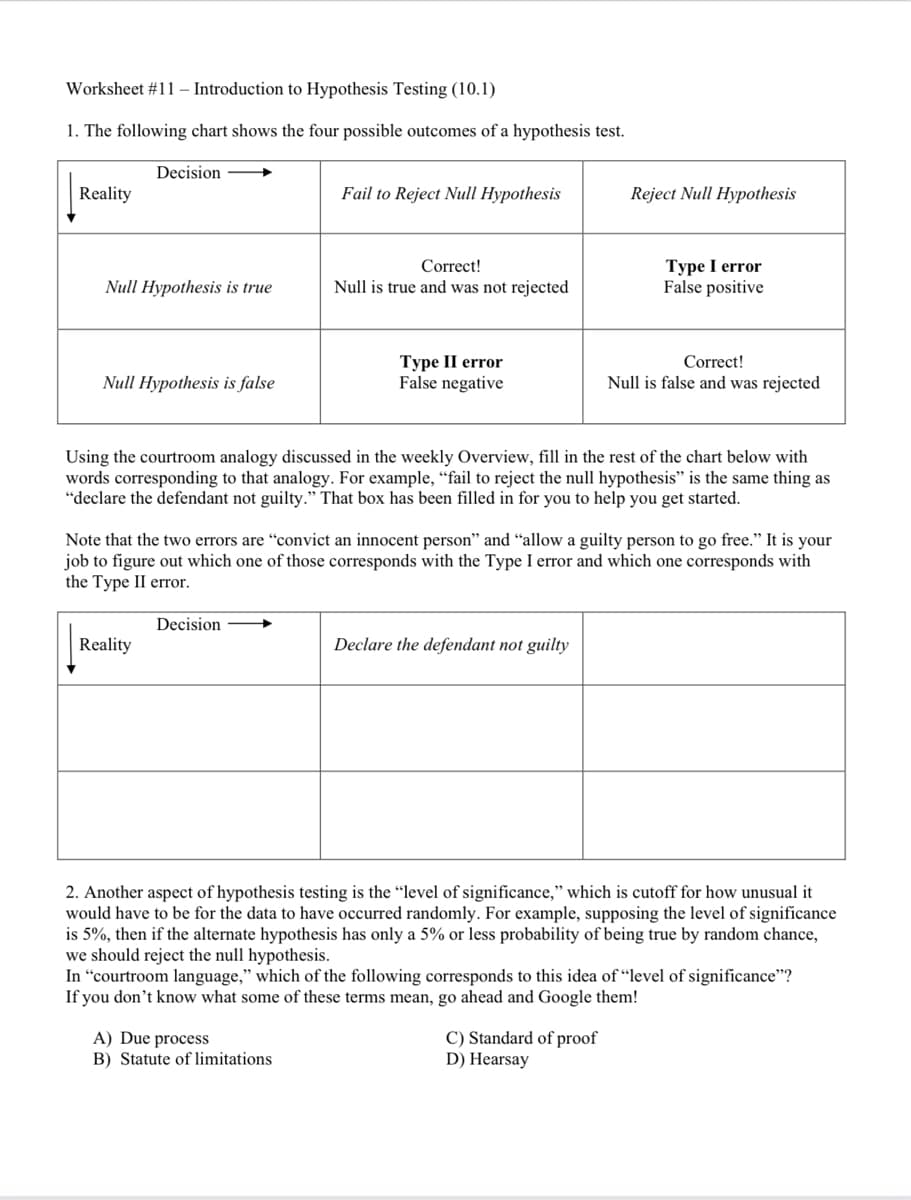Worksheet #11 – Introduction to Hypothesis Testing (10.1) 1. The following chart shows the four possible outcomes of a hypothesis test. Decision Reality Fail to Reject Null Hypothesis Reject Null Hypothesis Туре I error False positive Correct! Null Hypothesis is true Null is true and was not rejected Туре II error False negative Correct! Null Hypothesis is false Null is false and was rejected Using the courtroom analogy discussed in the weekly Overview, fill in the rest of the chart below with words corresponding to that analogy. For example, "fail to reject the null hypothesis" is the same thing as "declare the defendant not guilty." That box has been filled in for you to help you get started. Note that the two errors are "convict an innocent person" and "allow a guilty person to go free." It is your job to figure out which one of those corresponds with the Type I error and which one corresponds with the Type II error. Decision Reality Declare the defendant not guilty
Worksheet #11 – Introduction to Hypothesis Testing (10.1) 1. The following chart shows the four possible outcomes of a hypothesis test. Decision Reality Fail to Reject Null Hypothesis Reject Null Hypothesis Туре I error False positive Correct! Null Hypothesis is true Null is true and was not rejected Туре II error False negative Correct! Null Hypothesis is false Null is false and was rejected Using the courtroom analogy discussed in the weekly Overview, fill in the rest of the chart below with words corresponding to that analogy. For example, "fail to reject the null hypothesis" is the same thing as "declare the defendant not guilty." That box has been filled in for you to help you get started. Note that the two errors are "convict an innocent person" and "allow a guilty person to go free." It is your job to figure out which one of those corresponds with the Type I error and which one corresponds with the Type II error. Decision Reality Declare the defendant not guilty
Algebra & Trigonometry with Analytic Geometry
13th Edition
ISBN:9781133382119
Author:Swokowski
Publisher:Swokowski
Chapter10: Sequences, Series, And Probability
Section10.8: Probability
Problem 32E
Related questions
Question
hello can you answer number one
Using the courtroom analogy discussed in the weekly Overview, fill in the rest of the chart below with
words corresponding to that analogy. For example, "fail to reject the null hypothesis" is the same thing as
"declare the defendant not guilty." That box has been filled in for you to help you get started.

Transcribed Image Text:Worksheet #11 – Introduction to Hypothesis Testing (10.1)
1. The following chart shows the four possible outcomes of a hypothesis test.
Decision
Reality
Fail to Reject Null Hypothesis
Reject Null Hypothesis
Correct!
Null is true and was not rejected
Type I error
False positive
Null Hypothesis is true
Туре I error
False negative
Correct!
Null Hypothesis is false
Null is false and was rejected
Using the courtroom analogy discussed in the weekly Overview, fill in the rest of the chart below with
words corresponding to that analogy. For example, “fail to reject the null hypothesis" is the same thing as
"declare the defendant not guilty." That box has been filled in for you to help you get started.
Note that the two errors are "convict an innocent person" and “allow a guilty person to go free." It is your
job to figure out which one of those corresponds with the Type I error and which one corresponds with
the Type II error.
Decision
Reality
Declare the defendant not guilty
2. Another aspect of hypothesis testing is the “level of significance," which is cutoff for how unusual it
would have to be for the data to have occurred randomly. For example, supposing the level of significance
is 5%, then if the alternate hypothesis has only a 5% or less probability of being true by random chance,
we should reject the null hypothesis.
In “courtroom language," which of the following corresponds to this idea of “level of significance"?
If you don't know what some of these terms mean, go ahead and Google them!
A) Due process
B) Statute of limitations
C) Standard of proof
D) Hearsay
Expert Solution
This question has been solved!
Explore an expertly crafted, step-by-step solution for a thorough understanding of key concepts.
This is a popular solution!
Trending now
This is a popular solution!
Step by step
Solved in 2 steps with 2 images

Recommended textbooks for you

Algebra & Trigonometry with Analytic Geometry
Algebra
ISBN:
9781133382119
Author:
Swokowski
Publisher:
Cengage

Algebra & Trigonometry with Analytic Geometry
Algebra
ISBN:
9781133382119
Author:
Swokowski
Publisher:
Cengage